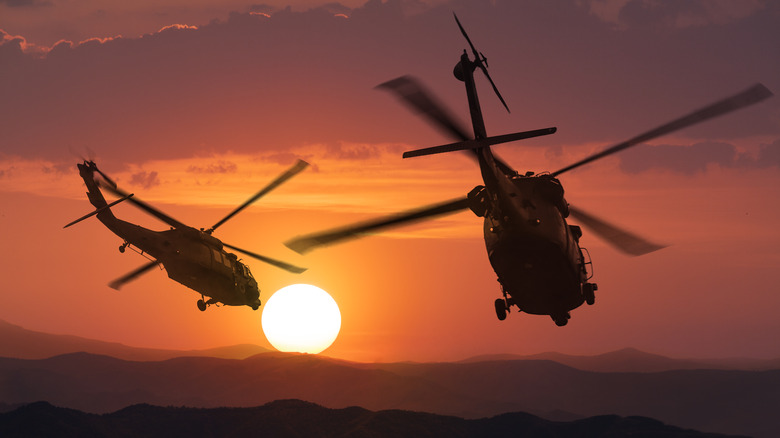
Guvendemir/Getty Images
While fixed-wing aircraft are one of the strongest parts of the United States’ air power, they don’t dominate the Army’s fleet. That’s because Army aviation instead relies heavily on helicopters. These days, the Army operates more than 5,460 helicopters of different types, which made up 41.2% of the U.S. military’s air power in 2022.
Advertisement
The Army primarily operates six helicopters, most of which were designed and put into service in the mid-20th century. Each helicopter, named after a Native American tribe, fulfills a variety of functions, from attack and close-air support to air assault and medical evacuation (medevac). The six helicopters in the Army inventory are the UH-60 Blackhawk, CH-47D Chinook, MH-6 Little Bird, AH-64 Apache, OH-58D Kiowa, and the UH-72 Lakota.
The other branches also have helicopters and operate many of the same models. Typically, these are given a different designation based on the primary airframe. Regardless, the Army operates thousands of individual aircraft developed by various defense contracts like Bell, Boeing, and Lockheed Martin, which is working on the next Army helicopter, the Sikorsky S-97 Raider. It will take several years before the Raider makes it into the inventory. Until then, these five helicopters continue to support Army operations.
Advertisement
UH-60 Black Hawk
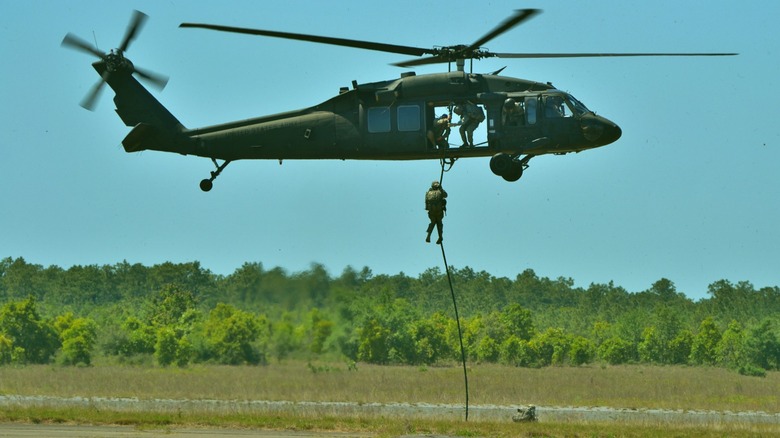
Mjf795/Getty
The Sikorsky UH-60 Black Hawk is the Army’s primary workhorse helicopter with 2,135 operating in the fleet. The Black Hawk has survived in the inventory for over 40 years, and over 5,000 had been built as of January 2023. There are several variations of Black Hawks operated throughout the military, though the Army primarily uses the UH-60M, which is the latest version of the aircraft. Black Hawks have been used for air assault, intelligence, surveillance, and reconnaissance (ISR), VIP transport, search and rescue, and much more.
Advertisement
A Black Hawk can transport 11 fully-equipped troops on a variety of missions, and it can be used to medevac wounded personnel from the battlefield. Reduced equipment allows for the maximum capacity of 20 lightly equipped personnel as well. Black Hawks can handle all-weather conditions and are operated by two pilots and two crew chiefs who also function as gunners. The helicopters have a combat range of 370 miles and a service ceiling of 19,000 feet.
Typically, a Black Hawk can utilize two mounted weapon systems capable of supporting the M-60 GP 7.62mm machine gun, the M240 machine gun, the .50 caliber GAU-19/A machine gun, and the 7.62mm M134 six-barreled minigun. The aircraft also boasts four hard points (two per stub wing), and can fire 70mm rockets, Hellfire or Stinger missiles, aerial mines, and additional guns. The Army began the process of replacing the UH-60 with the Textron-Bell V-280 Valor tiltrotor aircraft in 2022.
Advertisement
CH-47 Chinook
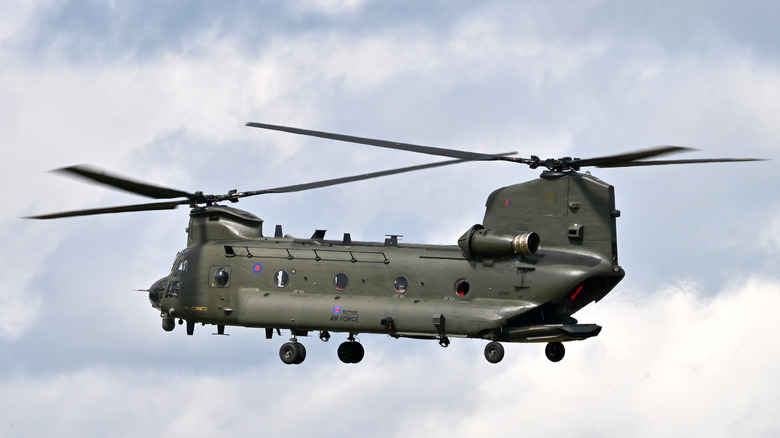
John Keeble/Getty Images
While the Army uses the UH-60 Black Hawk for transport, it’s hardly the only aircraft suited for that purpose. The Boeing CH-47 Chinook is the Army’s heavy-lift helicopter capable of carrying around 27,000 pounds of personnel and cargo. A Chinook can carry as many as 55 troops, making it capable of picking up and dropping off an entire platoon. Boeing’s CH-47 Chinook has been in flight for over 60 years, with 1,200 produced by August 2012. Despite its age, the Army plans to continue using the Chinook until 2060.
Advertisement
That would give the aircraft nearly a century of life, which is impressive, to say the least. Like other aircraft in the U.S. military, the Chinook has numerous variants, modernizations, and upgrades that have enabled it to continue operating for decades. The current version is the CH-47F Block 2, with Block 3 coming after 2025. The Chinook is primarily used for transport, but it’s not defenseless, thanks to its ability to support up to three medium machine guns.
These are typically the 7.62mm M240/FN MAG machine guns, though the Chinook can also support the 7.62mm M134 Minigun. The aircraft’s weapons systems are primarily used to support personnel during insertion and extraction, so they’re fitted to the loading ramp and shoulder windows. A Chinook has a maximum speed of 184 mph, a service ceiling of 20,000 feet, and a mission radius of 230 miles. The Army had 450 in its inventory as of March 2023.
Advertisement
MH-6 Little Bird
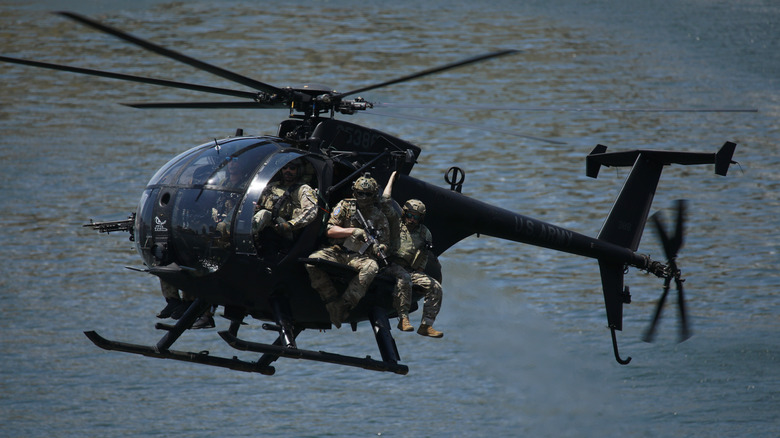
Luke Sharrett/Getty Images
The MH-6 Little Bird is a light helicopter that few outside the military know much about due to its exclusive use by Special Operations for the U.S. Army. Compared to the other choppers used by the Army, the Little Bird is considerably smaller, hence its name. The MH-6 first entered the service in the 1980s as a scout helicopter. Because they are designed to support operators, there are benches on the sides accommodating up to six personnel.
Advertisement
This allows for the MH-6 to make rapid insertion and extraction procedures as it doesn’t need to fully land, nor does it need to deploy ropes for air assault. It can also fit into smaller areas the Chinook and Black Hawk cannot. MH-6s are usually unarmed, leaving the AH-6 to function as an attack helicopter, depending on the mission. When armed, they can carry two AGM-114 Hellfire or two FIM-92 Stinger missiles.
The Little Bird can also fire Hydra 70 rockets and can support a 30mm M230 Chain Gun or two .50 caliber GAU-19 rotary machine guns. The aircraft has a range of about 260 miles and, if equipped, can provide overwatch and armed support for operators on the ground. The Little Bird is operated by two personnel and can fly up to 175 mph to a service ceiling of 18,700 feet. The Army was set to replace the Little Bird but canceled its plan, so the remaining 51 Little Birds could remain in operation well into the 2030s.
Advertisement
AH-64 Apache
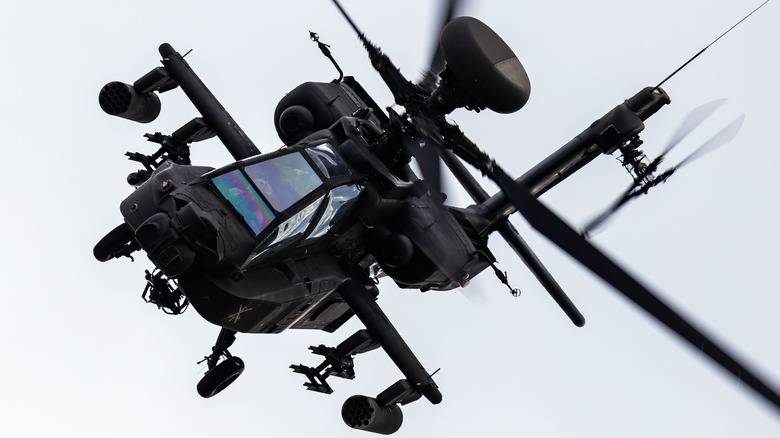
Soos Jozsef/Shutterstock
Of all the Army’s current helicopters, the Boeing AH-64 Apache is likely the most well-known. The attack helicopter has been operating for the U.S. Army since the mid-1980s, and it functions as the service’s primary attack aircraft. Since its introduction, Boeing had produced over 5,000 Apaches as of March 2024. The Apache replaced the AH-1 Cobra from the Vietnam era and remains one of the Army’s most efficient lethal airborne platforms today.
Advertisement
In terms of armament, the Apache isn’t lacking in firepower. A standard configuration outfits an Apache with a 30mm M230 Chain Gun, Hydra 70mm and CRV7 70mm rockets, AGM-114 Hellfire, and AIM-92 Stingers. These weapon systems enable the Apache to take on hardened targets, including enemy armor. The aircraft itself is hardened with 2,500 pounds of armor and its fuel system is self-sealing to further protect the aircraft and its two-person crew.
Since its introduction, the Apache has undergone numerous refits and modernization programs. There are also several variants operated by nations around the world. Thanks to their versatility and lethality, the AH-64D/E models will likely remain a vital element of future Army operations worldwide. The Apache is slated for retirement, after which it will be replaced by the Future Vertical Lift (FVL) aircraft set to arrive by 2030.
Advertisement
UH-72 Lakota
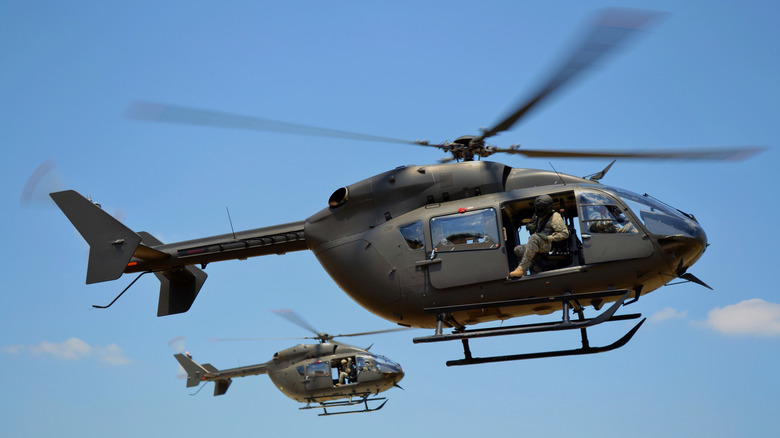
Mjf795/Getty Images
The UH-72 Lakota is the newest helicopter operated by the U.S. Army, having been first introduced in 2006. Since it entered the inventory, several hundred have been produced, with 463 rolling off assembly lines as of October 2021. The Army isn’t the only service that operates the Lakota, as the Navy and Army National Guard also use them for training and support operations. As of July 2024, the Army and Guard were operating 212 UG-72A and 18 UH-72B Lakota aircraft. These are used primarily for counter drug, search and rescue, and other missions.
Advertisement
The Lakota operates much like the Black Hawk and replaced the OH-58A/C Kiowa, which was officially retired. The Lakota is a militarized version of Eurocopter’s (now Airbus Helicopters) EC145, and while it has many of the same capabilities as the Black Hawk, the Lakota is reserved for helicopter pilot training and non-combat operations. This enables the far more expensive Black Hawk to take up the brunt of combat actions overseas.
For this reason, the active-duty force doesn’t rely on the Lakota nearly as much as the Guard. Lakotas are often utilized for medevac, disaster response, security, VIP transport, and command and control (C2) support. Unlike other helicopters used by the Army, the Lakota is unarmed. The aircraft can carry eight troops, is operated by up to two pilots, has a maximum range of 426 miles, a top ceiling of 18,000 feet, and can reach a top speed of 167 mph.
Advertisement